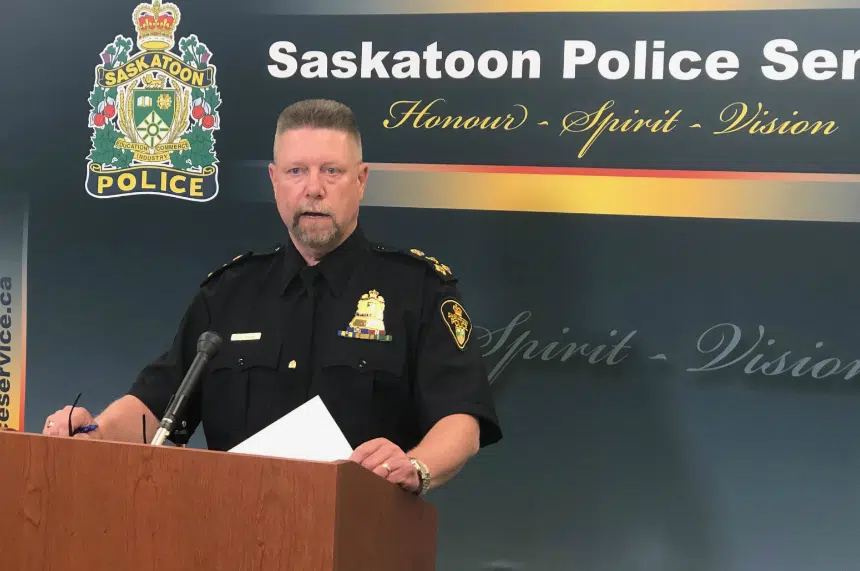Saskatoon Police Chief Troy Cooper gave an update on policing in the city, including what’s to be done with changes facing Saskatoon’s Wellness Centre and how body cameras are being received by officers in the city.
Wellness Centre changes
As the Wellness Centre prepares to transition from downtown Saskatoon to the Fairhaven neighbourhood, Cooper said the major job of police has been to so far keep pace with the discussions about what’s happening, the timeline for the transition, the services to be offered at the new location and the number of people who will be expected in the new space.
“(That’s being done) so that we can actually assess what we expect to see change in that neighbourhood,” Cooper explained.
The chief said police aren’t just waiting to see what concerns and problems might arise — instead, they’re proactively planning an appropriate response based on what needs are already apparent.
Police officers and staff have been included in regular meetings about the Wellness Centre, run by the Saskatoon Tribal Council, throughout the year. It goes beyond the need to have police assistance during the upcoming transition, Cooper shared.
Calling the Wellness Centre a “very responsible partner,” the chief said he’s been pleased and grateful for how open the centre has been to suggestions and advice based on what police have encountered related to the social service.
“When we do see challenges or issues arising that might affect public safety, we’ve been able to offer suggestions and they’ve been really willing to listen … and implement,” Cooper said.
Knowing that positive relationship exists will do a lot to make this location change easier, according to Cooper.
Police have been hearing concerns from the Fairhaven community, however. Cooper said regardless of who moves into the large, currently unoccupied building, there will be change for the community. However, there comes a legitimate concern, he said, when a major social service provider moves in down the street — particularly about degradation of the neighbourhood.
The Saskatoon Police Service’s plan is to prepare for that, assess the impact the Wellness Centre has, and have an appropriate public safety response at the ready. Cooper said it will be similar to how police prepared and adapted when the Wellness Centre first opened its doors in Saskatoon’s downtown last year.
Cooper anticipates impact, but said the work of the force will be to mitigate that — like the situation when a safe injection site was opened in the Pleasant Hill neighbourhood.
Community mobilization officers have been a big help in these areas, doing lots of non-enforcement community contact to maintain the feel of a community while providing a more frequent officer presence, Cooper explained.
That’s a big part of their long-term planning for the area around the Wellness Centre, too. However, the short-term goal is to know of the new resources and changes, ensure staff is present and be ready to respond as needed.
Cooper also noted the desire for Saskatoon police to make alternative response officers more permanent in the force. Over the past year, such officers have been part of a pilot project.
Wanting to see that transition into a permanent resource, Cooper has submitted an increased budget request, with $350,000 reserved for alternative response officers. It will provide a stable six-officer presence if approved, Cooper said.
“It gives us a stable program that provides visible, professional presence, particularly in areas where there is a pedestrian presence,” the chief said.
He added the duties of these officers complement the work of more traditional policing with a special attention to community safety concerns.
Body cameras seeing success with officers
Cooper says 40 cameras have been on officers since April in Saskatoon, with “extremely valuable” results.
Already, about 15,000 pieces of video have been gathered by police using those cameras. Cooper said the video has been able to provide additional evidence that has been helpful in investigations — “video that we would have had to rely on officer notes in the past,” he shared.
It also allows those involved in court proceedings, including Crown and defence lawyers, to see events unfold in a case rather than relying solely on notes and witnesses. That assistance is helping to expedite court processes and decisions, Cooper noted.
The chief called it a “very positive operational experience so far.”
Cameras so far have been divided up among traffic, patrol and foot patrol officers to see where they are most valuable in the force.
Given the success already with the program, Cooper said the plan for 2023 is to add a total of 40 more cameras — 20 early in the year and 20 later — doubling their current number to 80 by 2024.
Those additions will also give police a better idea of how much the program will truly cost.
“If we find that the cost is something that’s manageable, then that is absolutely the goal,” Cooper said of eventually outfitting every officer when asked by Gormley guest host Taylor MacPherson.
Saskatoon police were able to see the benefits of using the cameras in other police jurisdictions long before they arrived here, Cooper shared. The cost still remains the major unknown factor, requiring more people to comb through footage, pixelate people captured who aren’t involved in a situation, and send video off to court.
Cooper noted the cameras are a sound investment. He said earlier problems with the technology — like batteries draining too quickly in extreme cold — have already been overcome, resulting in quality video footage lasting the length of an officer’s shift when a camera is worn.







